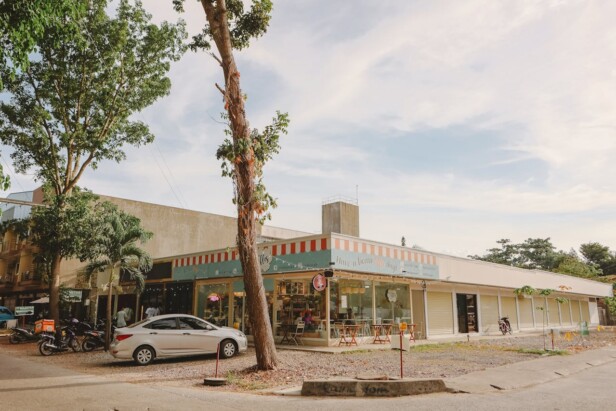Strip center renovations require more than basic construction knowledge. We coordinate multiple moving parts while keeping retail businesses operational throughout the project.
We manage commercial remodeling projects from preconstruction planning through final delivery, handling tenant build-outs, design-build services, and Houston permit coordination. Our role includes creating construction drawings when clients lack them, coordinating mechanical, electrical, and plumbing systems, and maintaining project schedules while protecting business continuity for operating tenants.
How Should You Plan A Strip Center Renovation To Minimize Downtime?

Successful strip center renovations require strategic preconstruction planning that prioritizes business continuity. We focus on protecting ongoing retail operations through careful sequencing and advance preparation. Early coordination reduces disruptions and maintains tenant income streams throughout construction.
Preconstruction planning forms the foundation of downtime reduction. We develop detailed phasing plans that identify which areas can remain operational while others undergo renovation. This approach allows tenants to continue serving customers and generating revenue during most of the construction period.
Implement Phased Construction Scheduling
Phased construction divides the project into manageable sections that minimize operational impact. We schedule work to affect only portions of the strip center at any given time. This method keeps the majority of retail spaces open and accessible to customers.
Temporary relocations should occur only when absolutely necessary to protect critical building systems or ensure worker safety. When relocations are required, we coordinate alternative arrangements that maintain business operations. Strategic phasing often eliminates the need for complete tenant displacement.
Order Long-Lead Materials Early
Material procurement timing directly affects construction schedules and potential delays. We identify long-lead items during preconstruction and place orders well ahead of installation dates. Early delivery and staged storage prevent schedule disruptions that could extend tenant downtime.
Critical materials include custom storefront systems, specialized HVAC equipment, and electrical components. We coordinate delivery schedules with building managers to ensure materials arrive when needed without creating storage conflicts. This proactive approach maintains project momentum and reduces unexpected delays.
Control Dust And Schedule Disruptive Work
Dust suppression protects adjacent retail operations from construction contamination. We use EPA-recommended dust control measures, including plastic barriers, HEPA filtration, and water misting during cutting operations. These methods keep airborne particles from affecting neighboring businesses.
Off-hours scheduling moves noisy and odorous tasks outside normal business hours. We perform demolition, concrete work, and mechanical system installation during evenings and weekends when possible. This timing protects customer experiences and allows retail operations to continue uninterrupted.
Off-site fabrication reduces on-site construction time and associated disruptions. We prefabricate components in controlled environments and deliver finished assemblies for quick installation. This method shortens the construction timeline and minimizes noise and dust generation at the job site.
Coordinate MEP Systems And Building Management
HVAC balancing and testing require careful coordination to avoid disrupting neighboring tenants. We schedule these activities during low-traffic periods and provide advance notice to building management. Proper system commissioning ensures optimal performance without extended operational interruptions.
Building manager alignment ensures compliance with property rules and tenant lease requirements. We establish clear communication protocols and coordinate access schedules with property management teams. This coordination prevents conflicts and maintains positive relationships throughout the construction process.
Design-build delivery offers enhanced control over design decisions, cost management, and finish quality. This approach allows us to make real-time adjustments that support business continuity objectives. Single-source responsibility streamlines decision-making and reduces potential delays that could extend tenant downtime.
What Scopes And Services Are Common In Houston Strip Center Upgrades?
Strip center upgrades in Houston encompass a wide range of construction scopes tailored to different business needs and property conditions. We handle tenant build-outs that transform empty shells into functional retail spaces, restaurant build-outs that require specialized equipment installations, and office renovations within mixed-use strip centers. Each project demands specific expertise in commercial construction and coordination with ongoing business operations.
Tenant Build-Outs And Space Conversions
Tenant improvements form the backbone of strip center construction work. We manage first-generation build-outs that involve installing new electrical service runs, plumbing waste lines, and mechanical system balancing for spaces never occupied before. Second-generation tenant improvements require retrofitting existing spaces to accommodate new business types, often involving layout changes and updated finishes.
Medical build-outs within strip centers present unique challenges with specialized ventilation requirements and accessibility compliance. We coordinate these installations while maintaining proper separation from adjacent retail operations.
Retail And Restaurant Renovations
Retail store remodeling projects focus on enhancing customer experience through updated layouts, improved lighting, and modernized finishes. We handle storefront modifications, fitting room installations, and display area configurations that support merchandise flow and shopping patterns.
Restaurant renovations demand coordination of kitchen equipment, dining area layouts, and specialized ventilation systems. We manage hood installations, grease trap connections, and fire suppression systems while ensuring compliance with National Restaurant Association standards and local health department requirements.
Interior Improvements And Support Spaces
Interior design and decorating services help businesses create cohesive brand imaging across their spaces. We coordinate paint applications, flooring installations, and fixture placements that reflect company identity while meeting durability requirements for commercial use.
Restroom and breakroom remodeling addresses both customer needs and employee facilities. These projects often involve ADA compliance upgrades, fixture replacements, and ventilation improvements within tight space constraints.
Office additions within strip centers serve businesses that need administrative space alongside their retail operations. We manage partition installations, electrical upgrades for technology needs, and climate control modifications.
Exterior Upgrades And Building Envelope Work
Storefront glazing projects improve visibility and energy efficiency while modernizing building appearance. We handle window and door replacements, ensuring proper sealing and integration with existing building systems.
Awnings provide weather protection and branding opportunities for strip center tenants. We coordinate structural attachments, drainage considerations, and permit requirements for these exterior additions.
Exterior lighting upgrades enhance security and business visibility during evening hours. We install LED systems, parking lot illumination, and accent lighting that meets local code requirements while supporting business operations.
Concrete work and site improvements address parking areas, walkways, and accessibility compliance. We manage repairs, resurfacing, and new installations that maintain safe pedestrian and vehicle access.
Specialized Services And Maintenance
Facility maintenance services help property owners maintain their investments over time. We provide ongoing support for mechanical systems, building envelope maintenance, and tenant-specific needs that arise during occupancy.
Insurance restoration work becomes necessary when weather damage or other incidents affect strip center properties. We coordinate with insurance adjusters, manage emergency repairs, and restore damaged spaces to pre-loss conditions while minimizing business interruption.
Brand imaging projects help businesses update their appearance and customer experience. We handle signage coordination, color scheme updates, and fixture modernization that reflects evolving brand standards and market expectations.
How Do Tenant Build-Outs Differ Between First-Generation And Second-Generation Spaces?

First-generation build-outs start with shell space that has never been occupied. These bare concrete boxes require complete infrastructure installation from the ground up. We coordinate electrical service runs from the main panel to individual spaces, install new plumbing waste lines for restrooms and break areas, and handle mechanical system balancing and testing to ensure proper HVAC performance.
The building shell typically provides only basic structural elements, exterior walls, and minimal mechanical connections. Our teams must frame interior walls, install complete MEP systems, and build out all finishes. This comprehensive scope includes ceiling installation, flooring, electrical outlets, data cabling, and lighting systems.
Second-Generation Space Advantages And Challenges
Second-generation spaces offer existing infrastructure that reduces construction complexity. Previous tenants have already installed electrical service runs, waste lines, and mechanical systems that we can often repurpose or modify. This existing infrastructure typically cuts build-out costs by approximately $10 per square foot compared to first-generation projects.
However, second-generation retrofitting presents unique challenges. We frequently encounter electrical systems that need upgrading to meet current code requirements or support new tenant equipment loads. Existing waste lines may require rerouting if the new layout changes restroom or kitchen locations. HVAC systems often need rebalancing to accommodate modified space layouts and different occupancy patterns.
The condition of existing improvements varies significantly. Some second-generation spaces require extensive demolition and rebuilding to accommodate the next tenant’s needs. Others may have infrastructure in excellent condition that needs only minor modifications and cosmetic updates.
Cost And Timeline Considerations
First-generation build-outs generally require 12 to 16 weeks for completion, depending on the scope and permit approval timeline. The comprehensive nature of shell build-outs allows for simultaneous MEP rough-in work, which can actually streamline the construction sequence despite the larger scope.
Second-generation projects often complete faster, typically within 8 to 12 weeks. The existing infrastructure allows us to focus on modifications rather than complete installations. However, retrofit work can encounter unexpected conditions that extend timelines, such as outdated electrical panels or mechanical systems that need replacement rather than simple modification.
The decision between first-generation and second-generation space depends on specific project requirements. First-generation build-outs provide complete design freedom and modern infrastructure but require higher upfront investment. Second-generation spaces offer cost savings and faster occupancy but may involve compromises in layout efficiency or require unexpected upgrades during construction.
How Do You Choose A Strip Center Renovation Contractor In Houston?
Essential Questions To Ask Before Hiring
Start by asking potential contractors about their years in business and specific experience with strip center projects. How many similar commercial renovations have they completed in Houston? Can they show examples of retail tenant build-outs, restaurant conversions, or multi-tenant properties they’ve managed?
Request proof of licensing and insurance for Texas operations. Every general contractor needs a valid state license, and they should provide certificates for liability insurance and workers’ compensation coverage. Ask about their team structure and who will be on-site managing daily operations.
Verifying Project Management Capabilities
A clear project management plan reveals how we approach complex strip center work. Ask contractors to outline their process for permits and Houston building code compliance. How do they handle quality control inspections throughout construction? What’s their system for managing changes and keeping projects on schedule?
Request a detailed estimate that breaks down labor, materials, and timeline milestones. The estimate should specify which permits they’ll handle and how they coordinate with local suppliers and subcontractors. We’ve found that contractors who provide thorough documentation upfront typically deliver smoother projects.
The Advantage Of Local Houston Contractors
Hiring local contractors offers significant benefits for strip center renovations. Local firms understand Houston building codes, have established relationships with suppliers, and know which subcontractors deliver quality work on schedule. They’re also nearby for ongoing support and warranty issues.
Local contractors typically maintain better supplier relationships, which can mean faster material delivery and competitive pricing. Their proximity allows for more frequent site visits and quicker response times when issues arise. This local knowledge proves especially valuable when navigating Houston’s permitting process and code requirements.
Checking Credentials And Reviews
Verify BBB ratings and Google reviews to assess reliability and communication skills. Look for patterns in feedback about project timelines, quality control, and how contractors handle unexpected challenges. Contact recent references directly to ask about their experience with strip center work.
Industry directories show that Houston general contractors commonly handle commercial and retail work, interiors, design-build services, and construction management. Check if your potential contractor specializes in these areas and can provide relevant project examples. We recommend focusing on firms with consistent positive feedback about communication and meeting deadlines.
Conclusion And Next Steps

Effective strip center renovation Houston projects succeed through strategic planning, well-defined scopes, and operational continuity. We focus on maintaining tenant operations while managing complex construction schedules and coordinating multiple trades. The foundation of any successful project lies in thorough preconstruction planning that addresses phasing, material procurement, and site logistics before work begins.
Property owners should first establish their delivery method preference between design-build and traditional bid-to-build approaches. Gather existing drawings or arrange for contractor-provided documentation services. Develop a comprehensive phasing plan that incorporates dust suppression protocols and noise control measures. Create a shortlist of licensed local contractors, verify their credentials through industry associations and online reviews, then conduct structured interviews covering project management processes, quality control procedures, and change order protocols. Align project timelines with operational requirements and budget parameters before mobilization occurs. Contact EB3 Construction to discuss your strip center renovation planning and phasing strategy.




